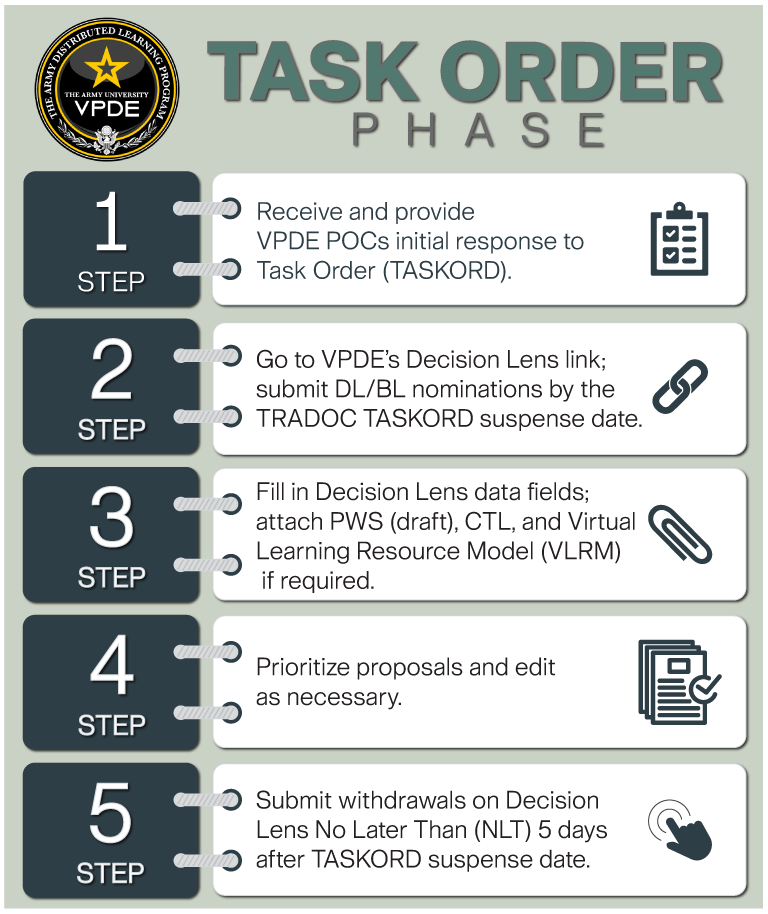
decision lens nominations process
The Vice Provost for Digital Education (VPDE) is modernizing the Distributed Learning / Blended Learning (DL/BL) nomination process. The Acquisitions and Management Division will implement Decision Lens for the first time to collect FY 26 nominations. Training Developers select from an array of portable devices and interactive software that use modern and proven instructional models to construct lessons. VPDE encourages Centers of Excellence to nominate training requirements that support the Warfighter by choosing DL/BL products that align with TRADOC’s Campaign Plan 5.0. The suspense for DL / BL nominations in Decision Lens is in APR 2024. The link to the submissions form is (Log In Required) https://tradoc-cac-dlx.decisionlens.com/contribute/t4PQnZ8tHrgUpKNuwP21mt/idea Proponents’ submission of strong nominations will advance the TRADOC ability to enable our soldiers to “deploy, fight, and win our nation’s wars”.
Planning
- Provide the Vice Provost of Digital Education (VPDE) with updated Points Of Contact (POC) list.
- Review Commanding General’s (CG) training guidance.
- Identify Doctrine, Organization, Training, Materiel, Leadership and education, Personnel, and Facilities (DOTMLPF) resources.
- Identify Government Furnished Information (GFI) for relevancy, accuracy, and completeness.
- Review Critical Task List (CTL).
- Establish learning objectives.
- Develop training strategy using Analysis, Design, Development, Implementation and Evaluation (ADDIE) process.
- Develop a Purpose of Work Statement (PWS) draft for each proposal.

pros and cons: contracted versus in-house development

Once planning for the distributed learning (DL) project has been completed, the next step is to determine which development option will work best for your organization. There are a number of considerations when planning either an in-house development project or a contracted effort. There are steps in each phase that need to be considered and they are discussed or linked to on this page. Once you have made your decision you can follow the correct path for Contracted or In-House.
PRACTICAL CONSIDERATIONS
Content for this page is abridged from the VPDE "Practical Considerations for In-House Development of Distributed Learning and Mobile Learning" paper. Download the entire paper and questions regarding required skill sets and content compliance here. This page provides guidance for Army DL managers and staff about what to consider when contemplating the use of an in-house development model rather than continuing the current practice of acquiring contractually developed (outsourced) DL courseware. VPDE maintains a neutral position and doesn’t advocate in-house development over contractually developed courseware. The focus of this page is on the minimum requirements.
to establish and maintain a viable in-house development team in a typical Army DL environment. The minimum essential requirements should be capable of supporting quality content design and development efforts, though proponents may find that in-house development may be best suited for lower-level content and interactivity (e.g., knowledge based activities). Contractual services may still be required (or preferred) for more intensely interactive content (e.g., games and simulations). As a consequence, any shift to in-house development by a proponent or agency may become a mixed operational model, relying on both in-house and contractually developed.
contracted development
The process for contracted development begins with nomination and prioritization of the work and continues with the development of the Performance Work Statement (PWS).
The PWS establishes contractor performance criteria and deliverable requirements for the development of DL courseware under a contract vehicle. These criteria and deliverable requirements also apply to sole-source contractors.
Schools use the guidelines to provide variable data that identifies the school, specific development requirements, technical requirements, unique design specifications, and GFI/GFM, when applicable.
Under the contract vehicle, the contractor provides personnel, material, equipment, facilities, and services, except as specified to be furnished by the Government, necessary to fulfill the requirements.
If contracted development is your choice, then you must nominate your content for consideration. To better prepare for Nomination, contact us.
in-house development
A working definition of “in-house development” is the combined capacity of an organization’s personnel, skill sets, training, software tools, facilities, equipment, and other resources leveraged in order to rapidly design, develop, and deploy Army Distributed Learning (DL) products to key stakeholders.
In order to develop and maintain an in-house development effort, training and education managers must understand the scope of this undertaking and answer a basic question of why they are pursuing this path. The first decision points for in-house development should involve a reasonable examination of the goals and objectives of such a move.
The proponent school that chooses in-house development should be mindful that ALL aspects of the TRADOC 350-70 regulation still apply, and now, may become the responsibility of local DL operational staff rather than contracting staff. In-house content is required to meet the same compliance and configuration standards as contractor content.
In order to develop and maintain an in-house development effort, training and education managers must understand the scope of this undertaking and answer a basic question of why they are pursuing this path. The first decision points for in-house development should involve a reasonable examination of the goals and objectives of such a move.
CONTRACTUAL FACTORS FOR CONSIDERATION:
- Project requires a fixed term commitment.
- No resources to re-allocate after the project.
- Expertise already available in project management, course design.
- Greater awareness of recent industry developments.
- Not influenced by internal politics, agendas.
- Possibly more credible than internal DL developers.
- Access to the latest specialized software.
- Current Distributed Learning financial model supports this method.
IN-HOUSE FACTORS FOR CONSIDERATION:
- Proponent/Client is in direct control of project.
- As partners proponents staff will enhance skills.
- Development over several DL projects significantly reduces costs.
- You know the unit/agency culture.
- Tools developed are generally better, easier to use for end-user.
- Generally delivers DL product faster, augmented features.
- New federal rules on out-sourcing (OMB A-76) more complex.
- Few, if any copyright problems, questions to be addressed.